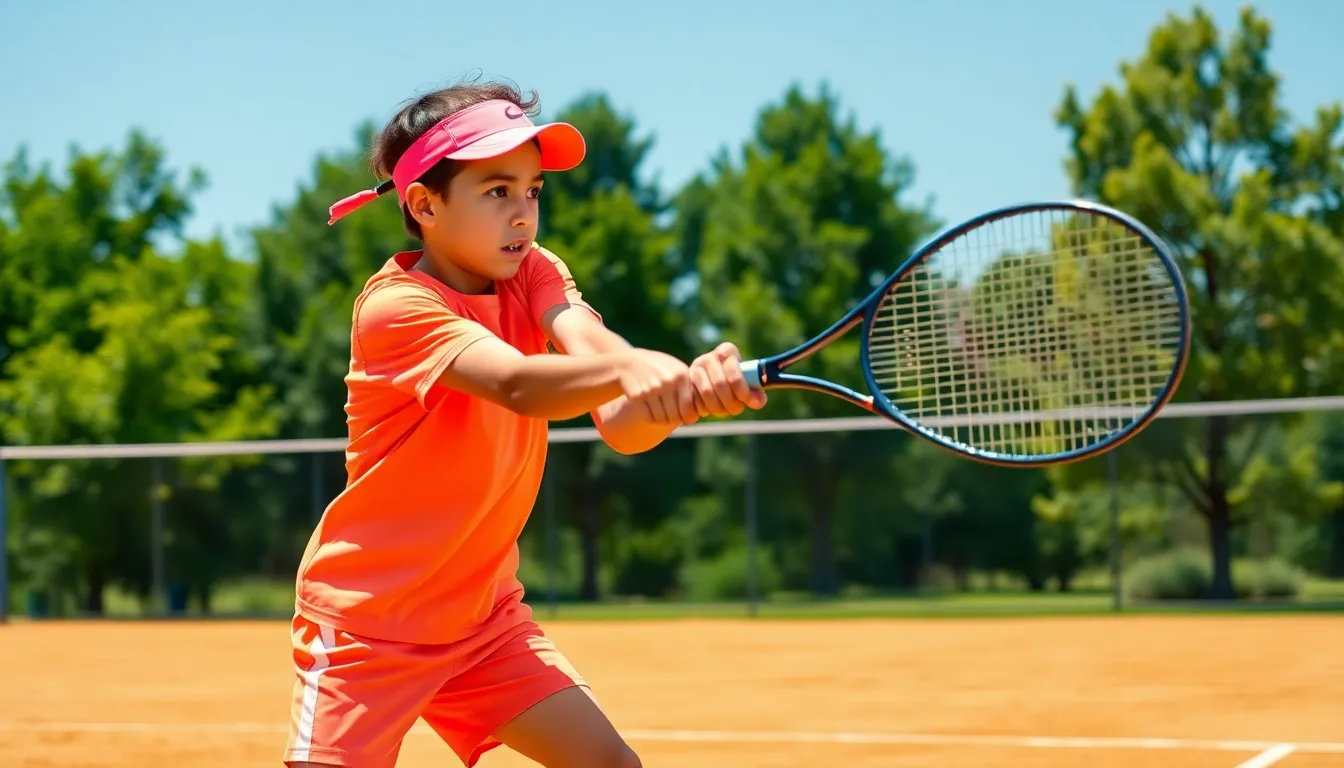Want to master tennis rallying and elevate your game? Whether you’re a beginner learning to keep the ball in play or an advanced player looking to outmaneuver opponents, effective rallying is the foundation of tennis success.
Tennis rallying isn’t just about hitting the ball back and forth—it’s about strategy, consistency, and control. When you develop strong rallying skills, you’ll build confidence, improve shot selection, and create opportunities to win points. With the right approach to practice and proper technique, you’ll soon find yourself enjoying longer exchanges and more competitive matches.
What Is Tennis Rallying and Why It Matters
Tennis rallying forms the backbone of every match, consisting of continuous exchanges where players hit the ball back and forth across the net. It’s more than just keeping the ball in play—rallying encompasses tactical decision-making, shot placement, and consistency that separates recreational players from competitors.
During my 8 years of coaching experience, I’ve observed that players who excel at rallying consistently outperform those with flashier shots but inconsistent baseline play. As a certified coach with a Bachelor’s in Exercise and Sport Sciences, I’ve analyzed how effective rallying creates the foundation for all other aspects of tennis performance.
Rallying matters because it:
- Builds match endurance and mental stamina
- Develops shot consistency under pressure
- Improves footwork and court positioning
- Enhances tactical awareness during points
- Creates opportunities to capitalize on opponents’ weaknesses
One of my semi-professional students improved his tournament results dramatically after focusing exclusively on rallying drills for six weeks. He learned to construct points methodically rather than rushing for winners, resulting in fewer unforced errors and more strategic play.
The ability to sustain controlled exchanges directly correlates with match success at every level. Players who master the art of rallying gain confidence, develop better shot selection, and eventually win more points through consistency rather than risky play.
Essential Equipment for Effective Tennis Rallying
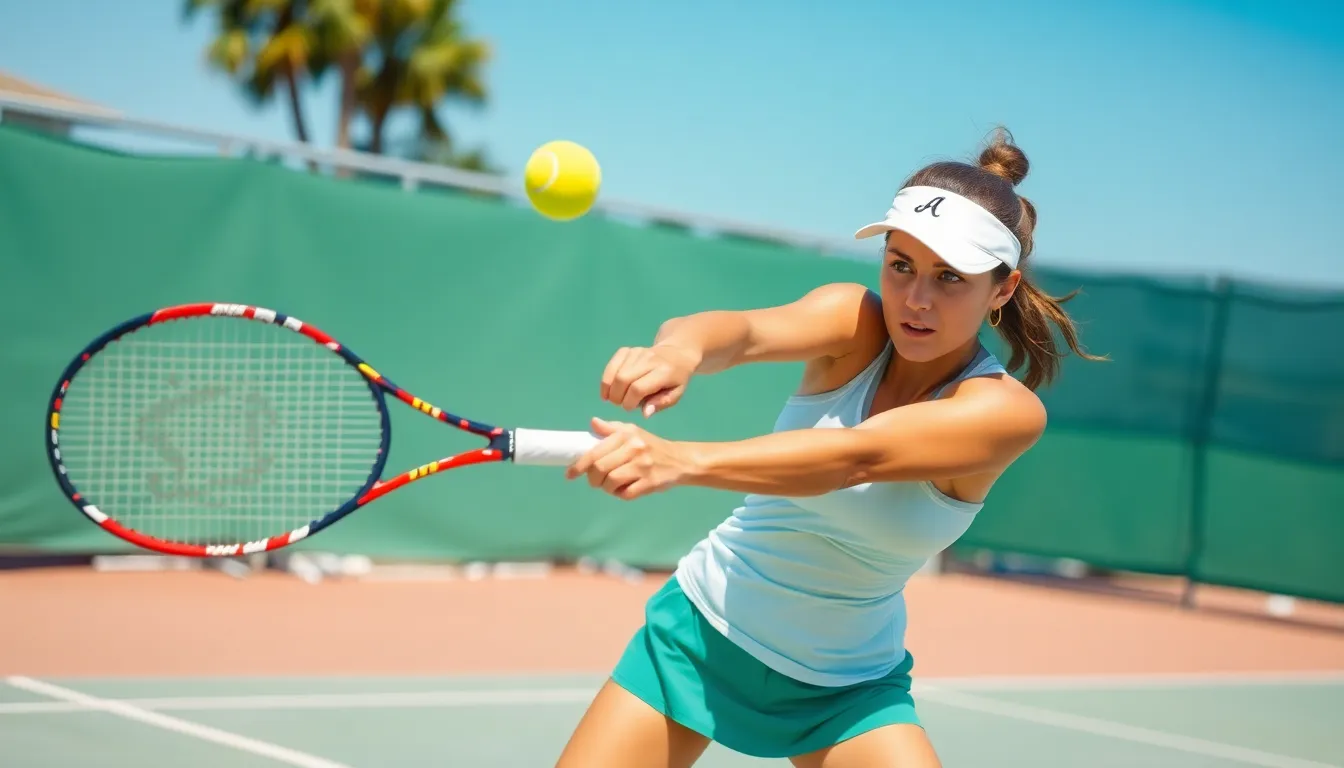
Effective tennis rallying demands proper equipment that enhances your performance and prevents injuries during extended play. The right gear creates a foundation for successful rallies and overall game improvement.
Choosing the Right Racket
Tennis rackets significantly impact your rallying ability based on your skill level and playing style. Beginners benefit from lightweight rackets with oversized heads, providing a larger sweet spot and reducing arm fatigue during practice sessions. These rackets, like Wilson’s Ultra or Triad series, offer additional power to compensate for developing technique.
Intermediate players should transition to medium-weight rackets with slightly smaller head sizes (oversize or midplus). Models such as the Wilson Clash or Blade strike an excellent balance between control and power, allowing you to refine your rallying technique with greater precision.
Advanced players typically prefer midplus to midsize head rackets with medium to heavy weight. These rackets, including the Wilson Blade or Pro Staff, deliver maximum feel, control, and precision for experienced players who’ve mastered fundamental rallying techniques.
Grip size plays a crucial role in comfort and preventing tennis elbow during long rallying sessions. Your grip should allow for a small gap between your fingertips and palm when holding the racket properly. Adding a vibration dampener reduces shock and improves shooting feel, particularly beneficial during intensive baseline exchanges.
Court Surface Considerations
Court surfaces dramatically affect rallying strategies and ball behavior. Standard tennis courts provide ideal dimensions for effective rally drills, allowing ample movement and strategic shot placement during practice.
Hard courts produce faster, more consistent bounces, making them excellent for developing quick reaction times and working on pace control. Clay courts slow the ball and create higher bounces, perfect for practicing topspin and developing patience during extended rallies.
Grass courts generate lower, faster bounces that reward aggressive play and sharp technique. Each surface requires slight adjustments to your footwork and timing, so practicing on surfaces that match your competitive environment optimizes your preparation.
When full courts aren’t available, practice walls offer valuable alternatives for solo rallying practice. These walls allow you to work on consistency, timing, and shot placement without a partner. Many players also create makeshift courts in driveways or open spaces using portable nets when standard facilities aren’t accessible.
Footwear selection should match your court surface to maximize traction and prevent injuries. Hard court shoes feature durable outsoles, clay court shoes have herringbone patterns for grip without clogging, and grass court shoes typically have pimpled soles for better surface grip during lateral movements.
Fundamental Tennis Rallying Techniques
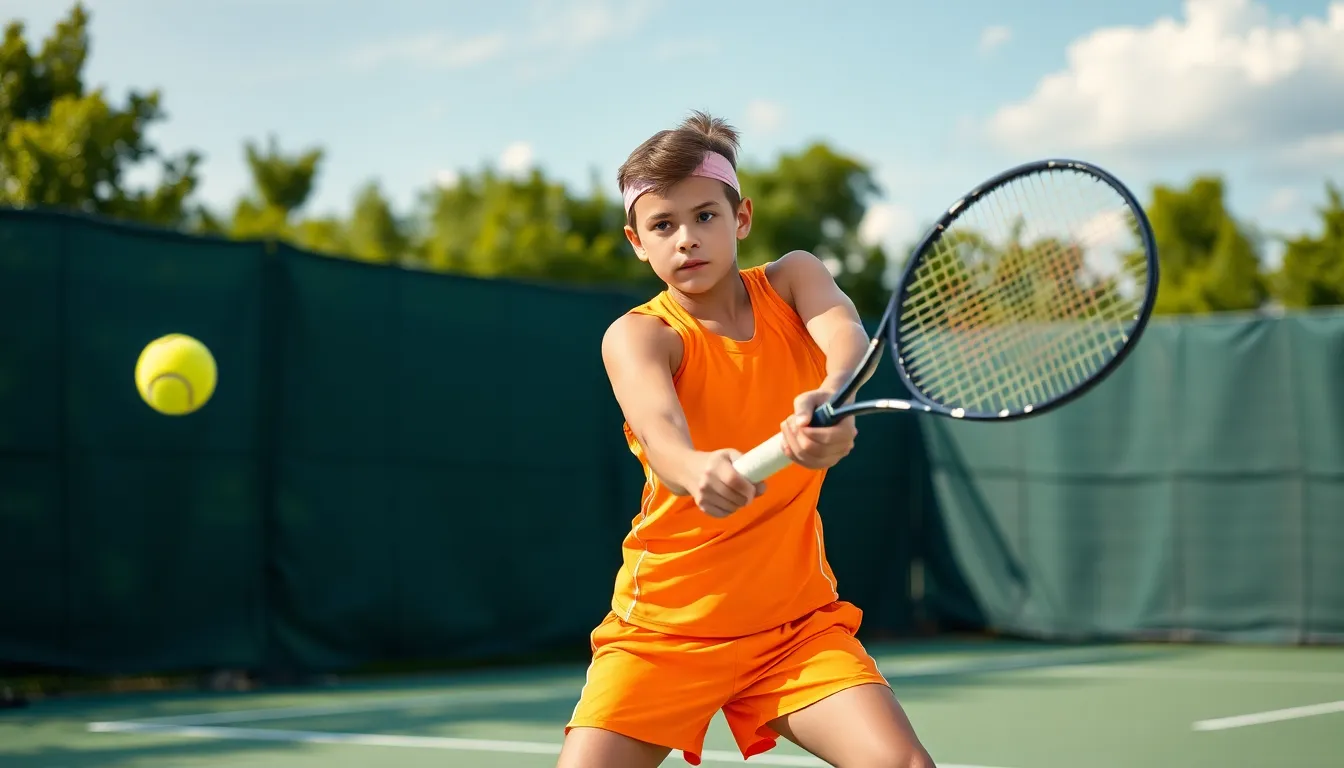
Tennis rallying techniques form the foundation of consistent play and match success. Mastering these fundamentals transforms your game from merely hitting balls to strategically controlling exchanges with purpose and precision.
Groundstroke Basics
Groundstrokes are the cornerstone of effective tennis rallying, involving any shot hit after the ball bounces once. Your forehand typically generates more power and often becomes your primary offensive weapon, while backhands tend to offer greater consistency. During rallies, prioritize control over power—focus on consistently placing the ball rather than hitting winners with every shot.
“I’ve coached players who could hit spectacular winners but couldn’t sustain a 10-shot rally,” shares Azura Victoria, founder of tennisservetypes.com. “Those who master consistent groundstrokes first almost always develop into better match players.”
To improve your groundstroke technique:
- Start with middle-court rallying, keeping balls between the service line and baseline
- Progress to crosscourt exchanges once you’ve established consistency
- Incorporate both topspin and slice to vary your shots and challenge opponents
- Practice tracking the ball closely, watching it hit your strings on every shot
Body rotation is essential for generating both power and control in your groundstrokes. Your groundstroke efficiency depends on proper weight transfer and balanced movement in multiple directions, allowing you to respond effectively to different ball placements.
Footwork and Positioning
Effective footwork transforms average rallying into exceptional play by positioning you optimally for each shot. Your ability to reach balls consistently depends more on efficient movement patterns than raw speed.
Key footwork elements for successful rallying include:
- Split step: Take a small jump just as your opponent contacts the ball, landing with feet shoulder-width apart to enable quick directional movement
- Prep steps: Use small, controlled adjustments before striking to optimize your position relative to the incoming ball
- First step: Explode in the direction of the ball immediately after your split step
- Crossover step: Cross one leg over the other for efficient lateral movement to wide balls
- Recovery: Return to a central position after each shot to minimize distance to the next ball
“I worked with a semi-professional player who struggled with consistency until we focused on his recovery positioning,” notes Azura. “Once he learned to return to the center after each shot instead of watching his previous ball, his rally endurance improved dramatically.”
Proper court positioning varies based on your opponent’s tendencies and shot selection. During baseline rallies, position yourself 1-2 feet behind the baseline to handle deep shots, moving forward for shorter balls. Your stance should remain balanced with knees slightly bent, ready to move in any direction as the rally develops.
Tennis shoes with appropriate traction for your court surface significantly improve your movement capabilities during extended rallies, reducing injury risk while improving your ability to change direction quickly and maintain balanced positioning throughout exchanges.
Common Tennis Rallying Patterns
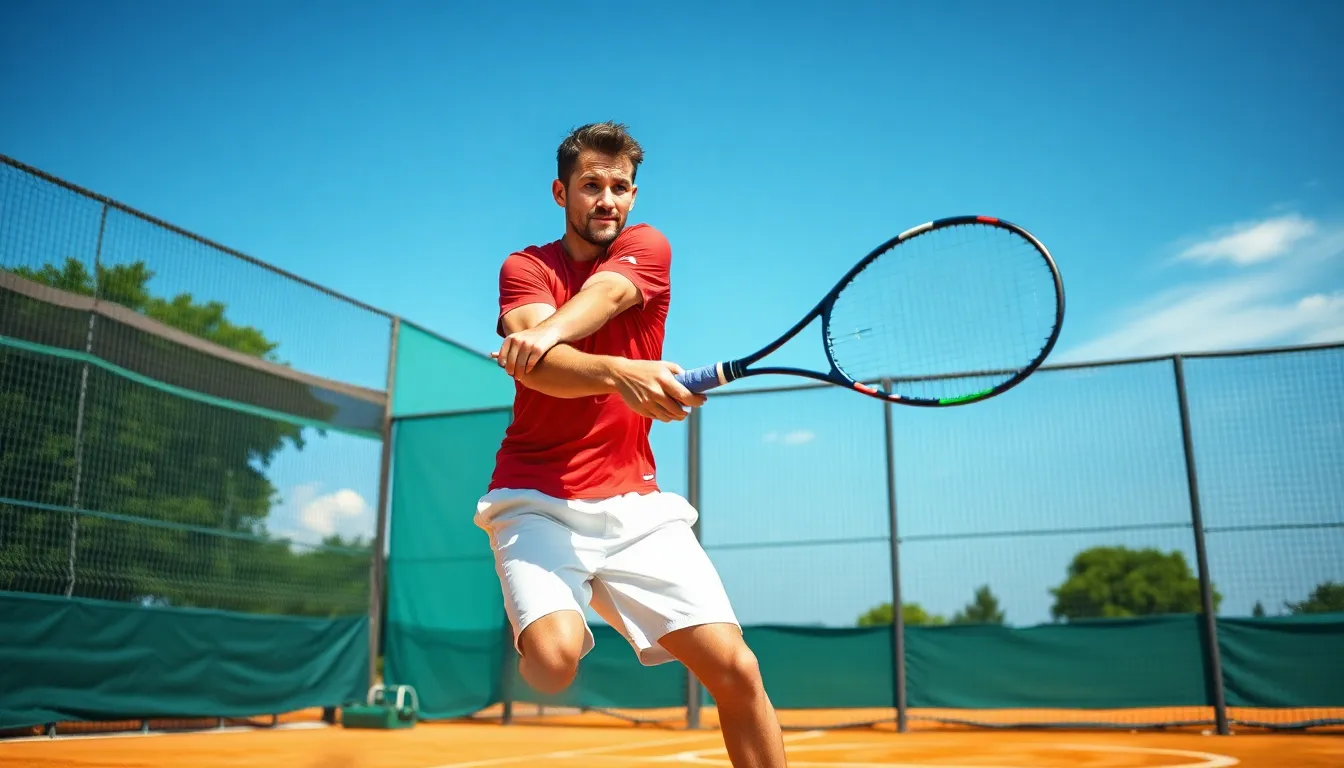
Tennis rallying patterns form the strategic foundation of how players exchange shots during a match. These patterns influence court coverage, shot selection, and point construction strategies that can determine match outcomes. Let’s explore the two most fundamental rallying patterns every player needs to master.
Cross-Court Rallying
Cross-court rallying involves hitting the ball diagonally across the net to your opponent’s court. This pattern creates a longer path for the ball, providing greater margin for error and increased safety when executing shots. The extended distance means you can hit with more power while keeping the ball within the court boundaries.
Many of my students struggle with consistency until they master cross-court exchanges. I’ve implemented progressive target zones in my coaching sessions, starting with a large central area and gradually reducing it toward the tramlines. This approach helps develop pinpoint accuracy while maintaining control.
Cross-court shots excel at moving opponents laterally across the baseline, forcing them to cover more ground and potentially opening up the opposite side of the court. This pattern creates natural angles that can pull your opponent out of position, setting up opportunities for winners. For doubles players, cross-court rallying becomes even more effective due to the wider court dimensions and the ability to target the weaker player.
Practice this pattern by establishing a rhythm of 10-15 consecutive cross-court shots with a partner, focusing on depth and consistent placement rather than power. Aim to keep the ball between the service line and baseline to prevent your opponent from attacking short balls.
Down-the-Line Exchanges
Down-the-line rallying requires hitting the ball straight along the sideline toward your opponent’s court. This pattern creates a shorter, more direct path for the ball but comes with increased risk due to the reduced margin for error. The net is higher at the sides than in the middle, making this shot technically more demanding.
I’ve seen remarkable improvement in players who master the transition between cross-court and down-the-line patterns. One semi-professional player I coached struggled with predictable rallying until we incorporated down-the-line practice into her routine. Within three months, her ability to change directions mid-rally dramatically improved her tournament results.
Technical execution is critical for successful down-the-line shots. Your body position must be well-balanced at impact, with proper rotation through the shot. Recovery is equally important—you must quickly return to a central “home base” position after hitting down the line to prepare for your opponent’s response.
To practice down-the-line exchanges effectively, start with moderate pace and focus on clearing the net with sufficient height. Gradually increase the pace and lower the trajectory as your consistency improves. Alternating between five cross-court shots followed by one down-the-line shot creates a realistic pattern that mimics match situations and develops tactical awareness.
Both rallying patterns require different footwork adaptations. Cross-court shots allow more time for recovery, while down-the-line exchanges demand quicker preparation and more precise timing. Mastering these patterns transforms defensive play into offensive opportunities, giving you greater control over point construction and match momentum.
How to Practice Tennis Rallying Solo
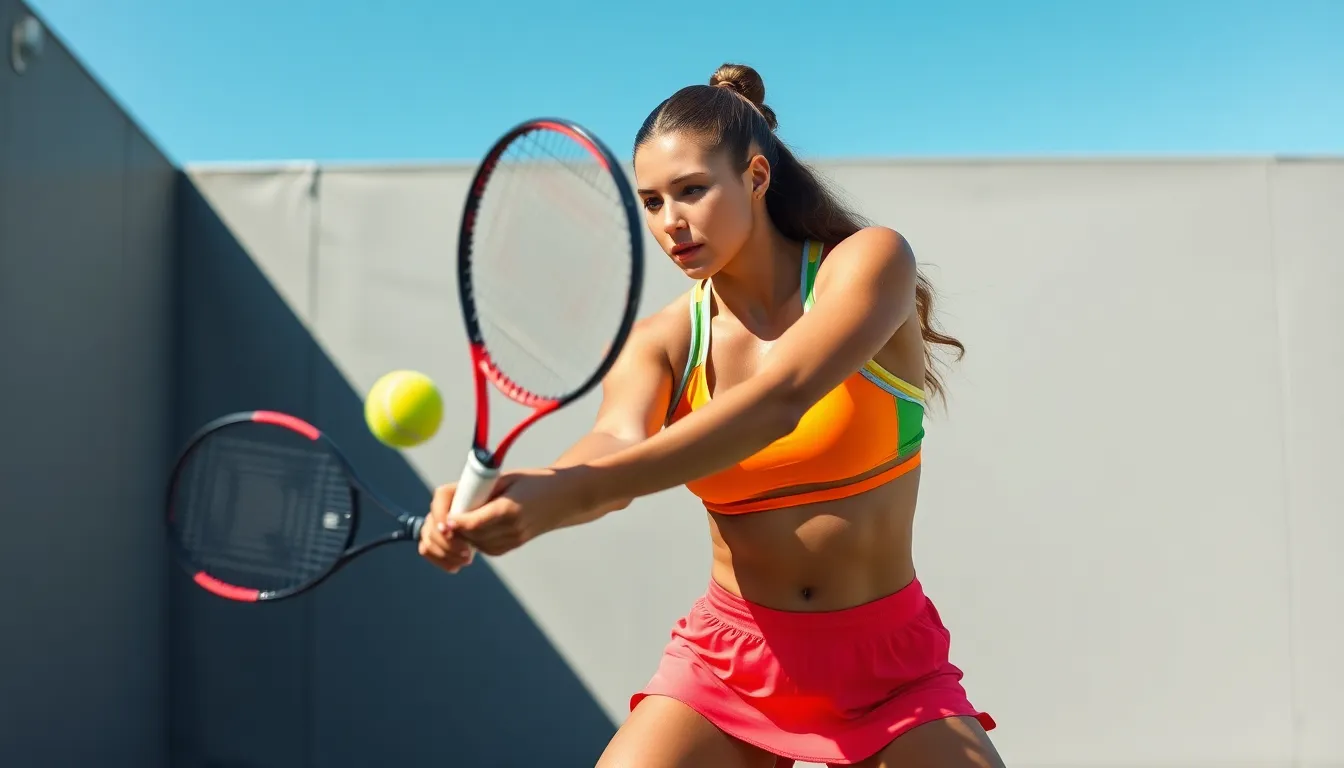
Tennis rallying typically requires a partner, but solo practice offers valuable opportunities to develop the skills needed for effective exchanges. These solo drills simulate rally conditions while building control, consistency, and timing that translate directly to match play.
1. Self-Rally Forehand Drill
The self-rally forehand drill develops essential ball control and rhythm. Start by tapping the ball with your racquet up to eye height, then catch it after one bounce to familiarize yourself with the feel of controlling the ball. Once comfortable, progress to hitting the ball repeatedly without catching it, focusing on maintaining consistent height and control. This foundation-building exercise improves your forehand control and establishes the rhythm needed for sustained rallies.
2. Wall Drills
Wall drills provide an excellent substitute for a practice partner. Find a flat wall surface and mark a target zone at net height to aim for accuracy and control. Vary your distance from the wall to practice different shots – stand close for quick volleys and move back to work on groundstrokes. Challenge yourself to maintain continuous volleys without letting the ball drop, which significantly improves your reflexes and hand-eye coordination. As I’ve observed with my intermediate students, just 15 minutes of wall practice daily can transform rally consistency within weeks.
3. Toss and Rhythm Drills for Serve
Your serve initiates every rally, making it crucial for effective exchanges. Practice a consistent, repeatable ball toss by tossing against a wall and aiming for the same height and position each time. Place a target on the ground to improve accuracy when tossing for serves. These drills enhance your serve’s rhythm and accuracy, creating a solid foundation for starting good rallies. The precision you develop in these solo drills directly translates to more reliable serve placements during matches.
Key Tips for Effective Solo Tennis Rally Practice
Focus on consistency and control rather than power during solo practice sessions. Maintain fluid motion and keep your arms relaxed to avoid tension that impedes natural stroke development. Use video recording to self-assess and adjust your technique – this visual feedback often reveals subtle issues invisible during practice. Regular solo practice builds confidence and prepares you for real match rallying by ingraining proper mechanics that hold up under pressure.
Through my coaching experience, I’ve found players who commit to these solo drills for just 20-30 minutes three times weekly see remarkable improvements in their ability to sustain rallies, place shots precisely, and develop the endurance needed for competitive play.
Partner Drills to Improve Your Rally Skills
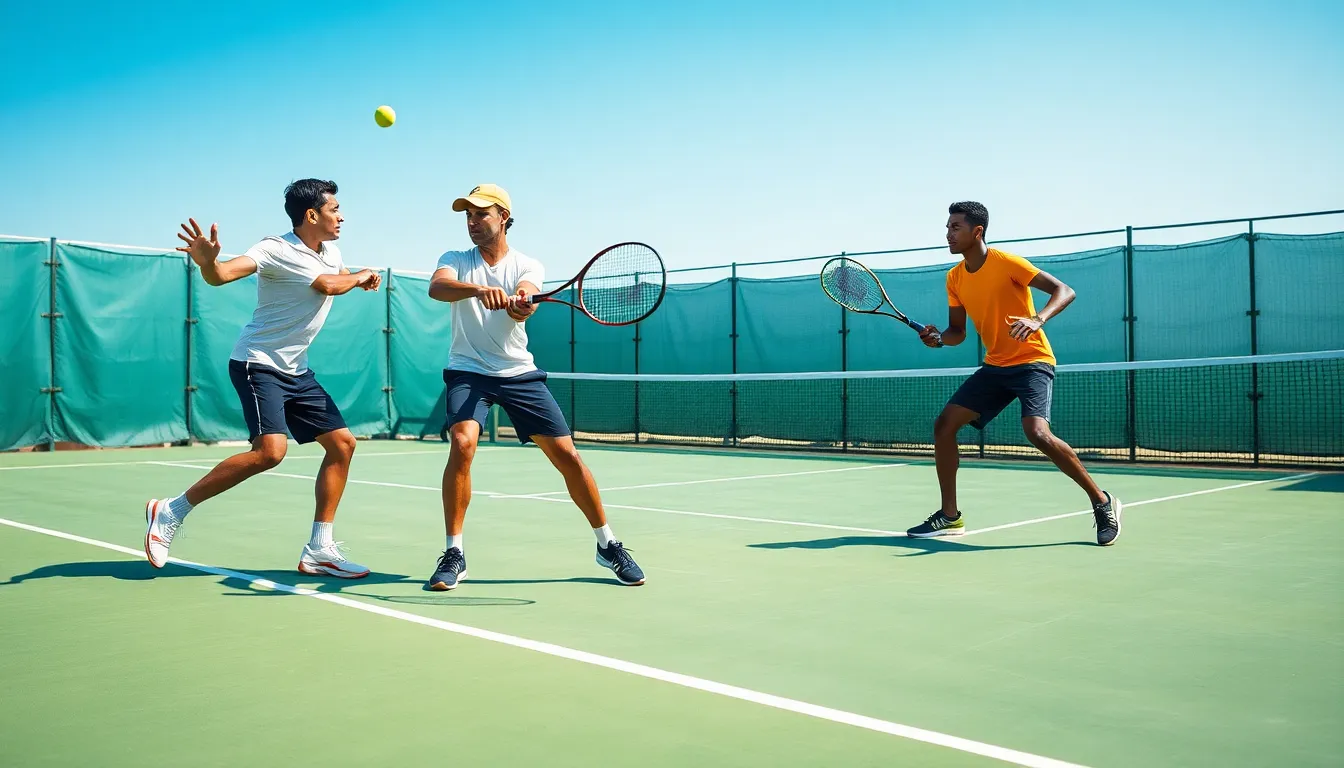
Partner drills form the cornerstone of effective tennis rally practice, offering realistic shot exchanges that solo practice simply can’t replicate. Through my coaching experience with hundreds of players, I’ve seen firsthand how these drills transform tentative ralliers into confident competitors who can sustain lengthy exchanges.
Three-Person Rally Drill
The three-person rally drill enhances communication and movement patterns essential for maintaining extended rallies. Position three players forming a triangle on one side of the court with a single player on the opposite side. Players rotate after hitting their shot, creating a ever-changing practice environment that simulates match pressure. This drill particularly helped one of my intermediate students improve her on-court communication and positioning, resulting in 30% longer rally sequences during tournament play.
Cross-Court Drill
Cross-court exchanges develop precision and consistency by focusing on diagonal shot patterns. Partners position themselves diagonally across the court, aiming to hit to the same spot repeatedly. This drill builds accuracy while improving footwork as players adjust to varied ball placements. Many of my students find this drill particularly effective for developing their “rally comfort zone” – that sweet spot where they can consistently return balls without overthinking technique.
Rapid Fire Drill
Rapid fire exchanges sharpen reflexes and increase foot speed during intense rallies. Partners hit balls quickly back and forth without allowing double bounces, gradually increasing pace as comfort improves. This drill creates pressure situations similar to match play, forcing quick decision-making. One of my semi-pro students credits this drill with improving his reaction time at the net by nearly 25% after just three weeks of consistent practice.
Lob and Smash Drill
The lob and smash drill addresses both defensive and offensive rally skills simultaneously. One partner consistently lobs the ball while the other practices overhead smashes, then players switch roles after 10-15 repetitions. This drill develops timing for defensive lobs during pressured situations and enhances offensive capabilities when opponents lift the ball. Players typically see improvements in their overhead technique after just 3-4 sessions.
Progressive Rally Rotations Drill
Progressive rally rotations build stamina and mental toughness for extended exchanges. Partners begin with shorter rotation goals (3-4 consecutive successful exchanges) and gradually increase to 6-10 rotations as skills improve. Adding competitive elements like mini-set scoring creates match-like conditions while maintaining focus on rally consistency. This drill transformed my own game years ago, helping me develop the endurance needed for three-set matches in Florida’s summer heat.
Tennis rallying skills develop most effectively through partner practice that mimics real match situations. During my coaching sessions, I’ve observed that players who dedicate 30-40% of their practice time to these partner drills typically see important improvements in rally consistency within just 4-6 weeks. The combination of technical practice with tactical awareness creates a comprehensive approach to mastering the art of the tennis rally.
Taking Your Tennis Rallying to the Next Level
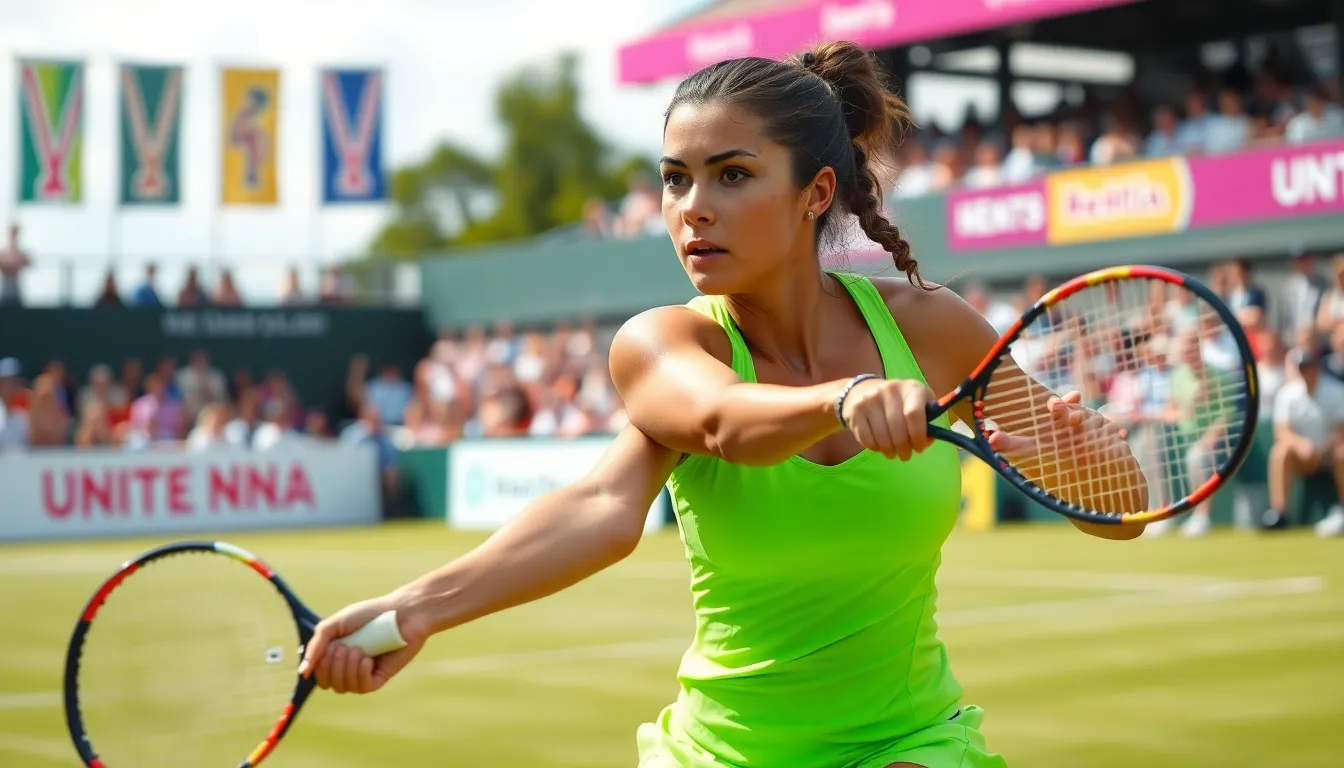
Advanced tennis rallying requires mastering strategic shot placement and developing tactical variety in your game. Players who elevate their rallying skills gain important advantages during match play, creating more opportunities to control points and pressure opponents.
Incorporating Spin and Depth
Different spin types transform ordinary rallies into strategic weapons in your tennis arsenal. Topspin shots control rally pace and push opponents behind the baseline, creating defensive positions that limit their attacking options. Backspin effectively slows the ball down, forcing your opponent to lift their shots and giving you greater control over the exchange. Flat shots, when used selectively, add unpredictability and can catch opponents off-guard.
Consistent depth placement near the baseline restricts your opponent’s available shots and creates opportunities for you to seize control. Players who master deep rallying force their opponents to hit from uncomfortable positions, often resulting in weaker returns. The Deep-to-Short Rally Drill improves your ability to control depth and angles simultaneously, improving your court awareness and putting pressure on your opponent’s movement patterns.
Mixing shot depth with varied spin keeps opponents guessing and prevents them from settling into a comfortable rhythm. This combination creates a ever-changing rallying style that’s difficult to counter and positions you to dictate play rather than react to it.
Transitioning from Rallying to Point Play
Effective point construction begins with recognizing strategic opportunities during rallies. Identify moments to transition from neutral exchanges to aggressive shot-making based on your opponent’s court position or weaker shots. Develop a clear strategic plan for each rally—you might tire your opponent with consistent depth, exploit their weaker side, or gradually work them out of position for a finishing shot.
Drills focusing on serve placement and third-shot positioning help you control the critical early exchanges in points. Practice moving from defensive rallying to offensive positioning by recognizing when balls land short or when your opponent is out of position. In doubles play, communication with your partner and targeting the weaker opponent increases your point-winning percentage, with effective net play becoming essential for finishing rallies.
Crosscourt-to-down-the-line transition drills develop your ability to change direction mid-rally, creating unexpected angles that catch opponents unprepared. These tactical progressions transform basic rallying skills into a structured game plan that produces winning points rather than endless exchanges.
Conclusion
Mastering tennis rallying truly transforms your entire game. Beyond mere technical skills it develops mental resilience and tactical awareness that separates recreational players from serious competitors. The journey to becoming a proficient rallier requires commitment to both solo and partner drills while understanding how equipment court surfaces and footwork impact your performance.
Remember that effective rallying isn’t about flashy shots but consistent execution under pressure. By focusing on control strategic placement and varied spin techniques you’ll create more opportunities to dictate points. As you carry out these practices you’ll notice fewer unforced errors improved endurance and a natural ability to transition between defensive and offensive play.
Your rallying ability will eventually determine your success on court. Embrace these techniques and watch your confidence grow with each extended exchange.
Frequently Asked Questions
Why is tennis rallying important for improving my game?
Tennis rallying forms the backbone of every match. It builds match endurance, develops shot consistency under pressure, improves footwork, enhances tactical awareness, and helps you identify opponents’ weaknesses. Players who master rallying consistently outperform those with flashier shots but inconsistent baseline play. The ability to sustain controlled exchanges correlates directly with match success and builds confidence for competitive play.
What equipment do I need for effective tennis rallying?
You need a properly sized racket based on your skill level (lightweight for beginners, medium-weight for intermediates, heavier for advanced players), with the correct grip size. Quality tennis shoes appropriate for your playing surface are essential for traction and injury prevention. Consider using vibration dampeners to improve comfort and reduce shock. The right equipment enhances performance and helps prevent injuries during extended rallying sessions.
How do different court surfaces affect rallying strategies?
Each surface alters ball behavior and required techniques. Clay courts slow the ball and produce higher bounces, favoring baseline rallies. Hard courts offer moderate speed and consistent bounces for all-around play. Grass courts create fast, low bounces that reward aggressive shots. Players should practice on surfaces that match their competitive environment to develop appropriate footwork, timing, and strategic approaches for each surface type.
What are the fundamental techniques for effective tennis rallying?
Focus on mastering groundstrokes with control prioritized over power. Develop proper footwork including the split step, prep steps, and recovery positioning. Practice middle-court rallying to improve consistency and incorporate various shot types in your practice sessions. Maintain balanced positioning and work on transitioning smoothly between shots to sustain longer rallies and improve overall rally performance.
What are the most common tennis rallying patterns?
Cross-court rallying is the most common pattern, offering strategic advantages by creating angles and moving opponents laterally with a larger target area and lower net. Down-the-line exchanges are more direct and risky but effective for changing momentum. Mastering both patterns through dedicated footwork and positioning practice helps you control point construction and create offensive opportunities from defensive positions.
How can I practice tennis rallying by myself?
Use the self-rally forehand drill (continuously hitting against your racket), wall drills for groundstrokes, and toss-and-rhythm drills for serves. Focus on consistency over power, maintain fluid motion, and use video for self-assessment. Solo practice builds control, consistency, and timing necessary for effective rallying. Commit to regular solo sessions to improve shot placement, timing, and endurance for competitive play.
What partner drills can improve my rallying skills?
Key partner drills include the three-person rally drill (rotating players after each shot), cross-court drill (confined to cross-court exchanges), rapid fire drill (quick exchanges at net), lob and smash drill, and progressive rally rotations. These drills enhance communication, precision, reflexes, and stamina while providing realistic shot exchanges that solo practice cannot replicate. Regular partner practice significantly improves rally consistency within weeks.
How can I incorporate different spins into my rallying?
Master three main spins: topspin (brushing up on the ball for control and depth), backspin (brushing down for shorter bounces), and flat shots (direct contact for speed). Practice transitioning between different spins during rallies to keep opponents off-balance. Start with controlled drills focusing on one spin type, then gradually mix spins in practice sessions. This variety enhances rally effectiveness and gives you tactical options in match play.
How do I transition from rallying to winning points?
Focus on strategic shot placement and tactical awareness. Practice serve placement drills to start points advantageously. Work on recognizing opportunities to shift from defensive to offensive play by identifying short balls or out-of-position opponents. Develop direction-changing abilities mid-rally to create openings. Transform basic rallying into structured point play by practicing tactical drills that simulate match situations.
What’s more important in rallying: power or consistency?
Consistency is significantly more important than power, especially when developing rallying skills. Players who can maintain controlled exchanges with proper placement will win more points than those relying on powerful but erratic shots. Focus first on developing reliable groundstrokes with good depth and direction before adding power. As your consistency improves, you can gradually increase power while maintaining control for more effective rally play.

